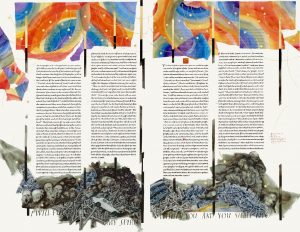
(Ezekiel 37:1-14)
The Valley of the Dry Bones offers perspective as we continue to delve deeper into our season of Lent. For Catholics, and other Christians who celebrate this solemn season, fasting, prayer, and service are three major pillars. For many, living out these pillars is not an easy task. There are many temptations and struggles, but these practices are not made to make us suffer. They help us every day to learn more about who we are, and what has become “gods” in our lives.
This image comes at a perfect time, a time when in our journey we can feel dry and empty, like all our sacrifices are useless or the struggle has become too hard. One can also realize how dead we have become, falling into ways where we are not necessarily living our true authentic self. The bright colors that run across the top represent hope. Hope in the struggles and trials of our own realities, a hope that goes beyond death. Along with the golden squares throughout the image, these represent the presence of our creator God. One can also see that even among the dry bones we find these squares; not only does God have power over death but, even in death God is present. Let this image remind us of the call that echoes not only through these days of Lent, but every day. A call to be a people of hope, bringing this hope to everyone we meet, especially the poor and marginalized in our society. A call to be present to one another, even in the midst of death.
This commentary was contributed by James Gumataotao, a senior Theology major and a member of the Library’s Research Desk team.